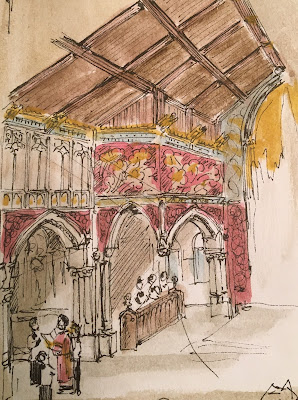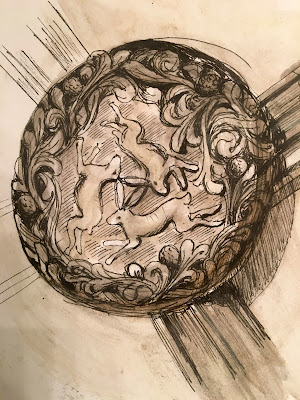Completing the Gothic Aesthetic of a Parish Church
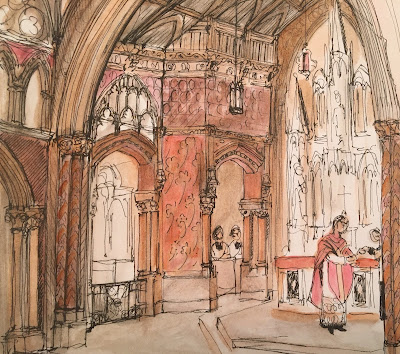 Sometimes at NLM we feature the work of new artists and architects doing projects from scratch. At other times we have featured marvelous examples of renovations that have undone some or all of the evils of a former wreckovation (usually from the sixties or seventies). Today I am pleased to share some conceptual renderings by a young architect, Kevin Athelney, who is working to complete the "Gothicization" of a church built only a few years ago -- Our Lady of Mount Carmel, the FSSP parish in the Denver archidiocese. The project is quite extensive in scope and shows a fine sense of consistency of style and attention to detail, both on the inside of the building and in its external appearance. It is a great example of taking a good thing and making it even better. The text below was supplied to me by Mr. Athelney. The parish hall is also undergoing renovation, as the painting below indicates. * * *When the new church for Our Lady of Mount Carmel was built it was done so as an "interpretation" of the Gothic style, but with some elements left missing in order to make the project manageable and to fill an urgent need for a better church building. The purpose of the work being done at present is to address the unfinished aspects and to bring the church from an interpretation of the Gothic to an authentic execution of the style. Specifically, the church will be refinished in the English Gothic Revival as developed by the nineteenth-century architect A.W.N. Pugin. Not only have Pugin's buildings served as inspiration, but the design philosophy is also strongly formed by his writings on the principles of Gothic architecture.A faithful execution of any Gothic building requires a great awareness of the integrity of the structure itself. That is, a modern building constructed from structural steel, stick framing, and drywall cannot convey the sense of solidarity, mass, and permanence that a true Gothic building does. When working with a modern structure, we can do our best to minimize those lacunae. Arcades will be added in the Sanctuary, and compound piers added to "hanging arches" in the Nave to augment the building's integrity. A decorated oak-beamed ceiling will be added to the sanctuary, and the walls will be decorated in polychromed and gilt stencil work. Dozens of custom wood, plaster and cast mortar mouldings, corbels, statues, bosses, capitals and splays for arches will be made to properly adorn the church, as any Gothic building requires a profusion of carved work. Not only is the design work done by my company, but many of the elements are custom made "in-house," giving the assurance that the end product will match the design concept both technically and in the desired feel. The carved stone work, mouldings, wall patterns, painted and gilt work, the wooden ceiling, and many other features, are all completed in my own workshop. I should like to note that a majority of the new architectural features, such as columns, archways, and the ceiling, are constructed off-site in modular units that can be installed relatively quickly with minimal interruption to the parish's schedule.The project will take many years and is to be done is stages. The Sanctuary will be the first stage of the refinishing project to be completed.Picture #1: Scale drawing and watercolour of the new decorated timber beamed ceiling for the Sanctuary
Sometimes at NLM we feature the work of new artists and architects doing projects from scratch. At other times we have featured marvelous examples of renovations that have undone some or all of the evils of a former wreckovation (usually from the sixties or seventies). Today I am pleased to share some conceptual renderings by a young architect, Kevin Athelney, who is working to complete the "Gothicization" of a church built only a few years ago -- Our Lady of Mount Carmel, the FSSP parish in the Denver archidiocese. The project is quite extensive in scope and shows a fine sense of consistency of style and attention to detail, both on the inside of the building and in its external appearance. It is a great example of taking a good thing and making it even better. The text below was supplied to me by Mr. Athelney. The parish hall is also undergoing renovation, as the painting below indicates. * * *When the new church for Our Lady of Mount Carmel was built it was done so as an "interpretation" of the Gothic style, but with some elements left missing in order to make the project manageable and to fill an urgent need for a better church building. The purpose of the work being done at present is to address the unfinished aspects and to bring the church from an interpretation of the Gothic to an authentic execution of the style. Specifically, the church will be refinished in the English Gothic Revival as developed by the nineteenth-century architect A.W.N. Pugin. Not only have Pugin's buildings served as inspiration, but the design philosophy is also strongly formed by his writings on the principles of Gothic architecture.A faithful execution of any Gothic building requires a great awareness of the integrity of the structure itself. That is, a modern building constructed from structural steel, stick framing, and drywall cannot convey the sense of solidarity, mass, and permanence that a true Gothic building does. When working with a modern structure, we can do our best to minimize those lacunae. Arcades will be added in the Sanctuary, and compound piers added to "hanging arches" in the Nave to augment the building's integrity. A decorated oak-beamed ceiling will be added to the sanctuary, and the walls will be decorated in polychromed and gilt stencil work. Dozens of custom wood, plaster and cast mortar mouldings, corbels, statues, bosses, capitals and splays for arches will be made to properly adorn the church, as any Gothic building requires a profusion of carved work. Not only is the design work done by my company, but many of the elements are custom made "in-house," giving the assurance that the end product will match the design concept both technically and in the desired feel. The carved stone work, mouldings, wall patterns, painted and gilt work, the wooden ceiling, and many other features, are all completed in my own workshop. I should like to note that a majority of the new architectural features, such as columns, archways, and the ceiling, are constructed off-site in modular units that can be installed relatively quickly with minimal interruption to the parish's schedule.The project will take many years and is to be done is stages. The Sanctuary will be the first stage of the refinishing project to be completed.Picture #1: Scale drawing and watercolour of the new decorated timber beamed ceiling for the Sanctuary Picture #2: Photo of renderings of the three ceiling bosses, crown moulding tracery, and string course for the Sanctuary with the first sculpted boss.
Picture #2: Photo of renderings of the three ceiling bosses, crown moulding tracery, and string course for the Sanctuary with the first sculpted boss.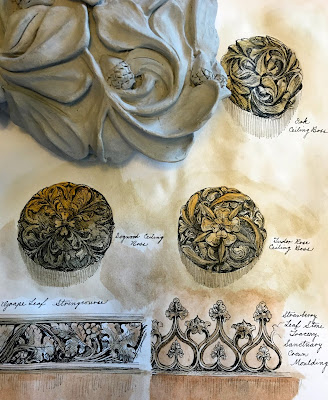 Picture #3: Conceptual rendering of the remodeled Sanctuary
Picture #3: Conceptual rendering of the remodeled Sanctuary Picture #4: Conceptual rendering of the new Western Front of the church, and proposed tower and spire to be completed after the church is lengthened.
Picture #4: Conceptual rendering of the new Western Front of the church, and proposed tower and spire to be completed after the church is lengthened.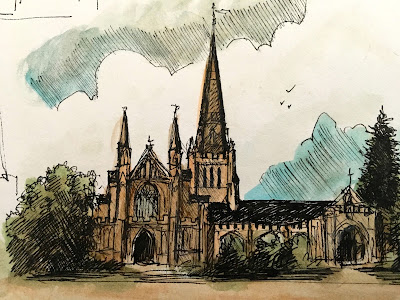 Picture #5: Conceptual rendering of the parish hall based upon the collegiate halls of Oxford University.
Picture #5: Conceptual rendering of the parish hall based upon the collegiate halls of Oxford University.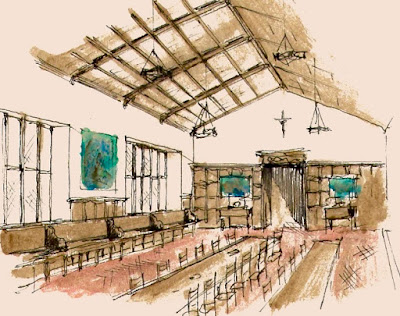 Below are some further sketches from the brainstorming process.
Below are some further sketches from the brainstorming process.